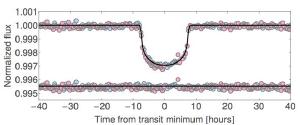Blog
Snow Queen
1 August 2014
 NASA/Ames Research Center
NASA/Ames Research CenterKepler-421b is a cold world orbiting a star about 1,000 light years away. At least according to a new paper announcing its discovery.1 This work hasn’t yet been peer reviewed, but it looks quite promising. What makes the discovery a big deal is that it is the longest period planet to be discovered by the transit method.
The transit method of exoplanet discovery (as many of you might recall) is where the brightness of a star is measured over time, looking for small dips at regular intervals. When a planet passes in front of its star, it blocks some of the starlight, making the star appear slightly dimmer. The advantage of the transit method is that it is relatively straight-forward, and can be used to discover lots of planets. The method has two big disadvantages, however. The first is that it requires the orbit of the planet to be along our line of sight. If it is tilted slightly relative to us, then we won’t observe a transit. The second is that it favors close orbiting planets over more distant ones. The more distant a planet from its star, the less likely its orbit is to be along our line of site, and the longer its orbit, the less transits we can observe in a given period of time.
 Kipping et al
Kipping et alFor Kepler-421b, only two transits have been observed. It’s orbital period is 704 days, so that means it is nearly two Earth-years between transits. If the observation period for the Kepler telescope had been earlier or later by a few months, we’d only have gathered one transit, which wouldn’t be enough to verify the planet. Normally even two transits isn’t enough to be sure, but these particular transits are a particularly good fit. You can see this in the image, where the blue dots are from the first transit and the red dots from the second.
Given the distance from its parent star, Kepler-421b is also past what is known as the “snow line” of the system. This line marks the distance where volatiles such as water, methane and other molecules are cold enough to condense or freeze. It is thought that gas planets form beyond the snow line, which is how they can gain such mass and volatiles. Often, gas planets will form beyond the snow line, but then migrate inward toward the star, which is why we find planets such as “hot jupiters” close to a star. Kepler-421b is a Neptune-sized world, so it likely formed near its current location.
Kipping, David M., et al. “Discovery of a transiting planet near the snow-line.” The Astrophysical Journal 795.1 (2014): 25. ↩︎